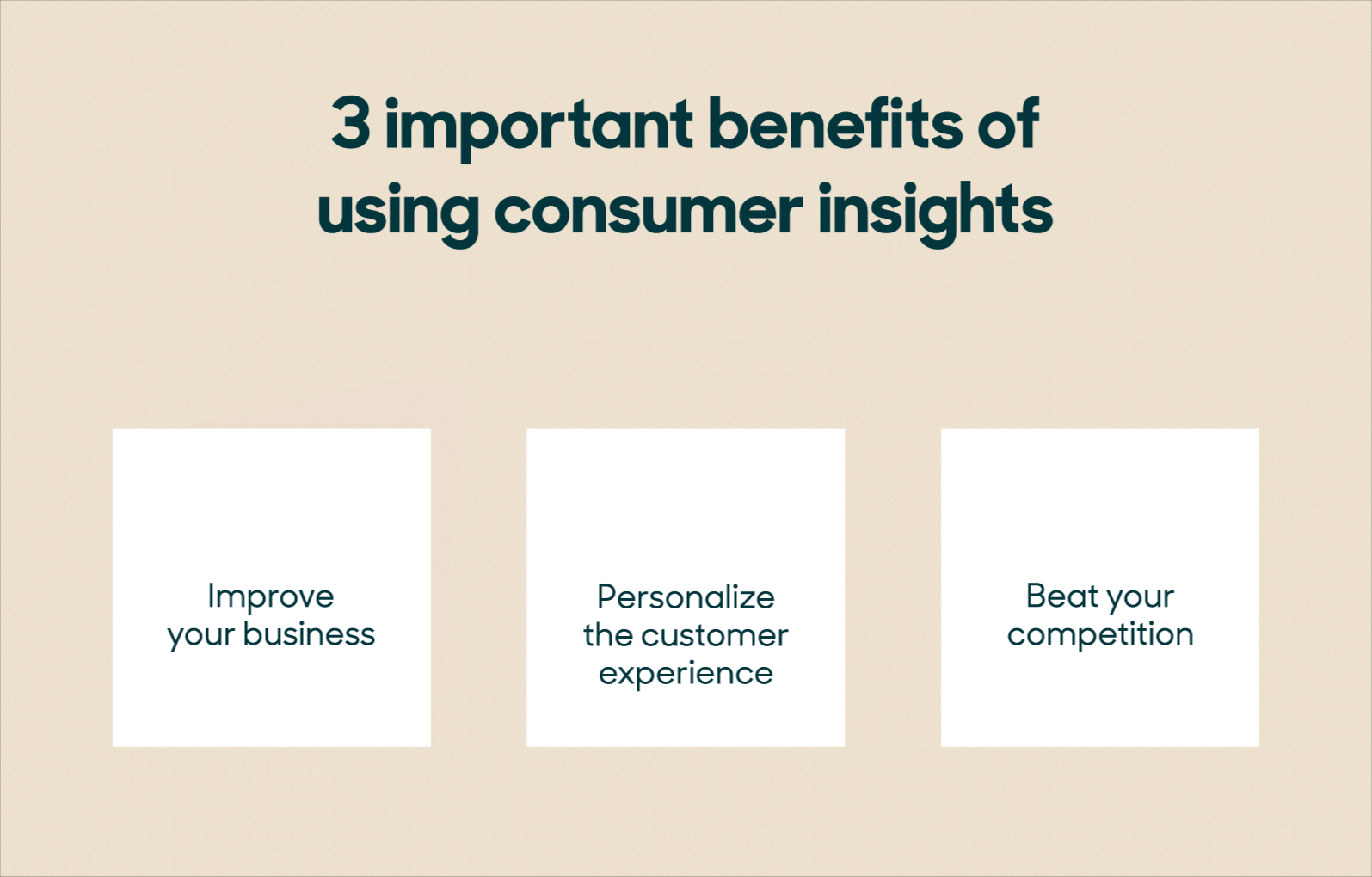Article • 8 min read
What are consumer insights? The ultimate guide on how to use them
Consumer insights provide information about a specific group of buyers and what they want. Learn how to get customer insights and use them to elevate your business and the customer journey.
By Cristina Maza, Contributing Writer
Last updated February 14, 2023
Running a business without consumer insights is like being hired as a chef without knowing how to cook. You might have all the ingredients to make the best Mexican food in the world, but without understanding how the spices and flavors work together, you might end up with a menu full of bland dishes and an empty dining room. Using consumer insights effectively can be the secret sauce that keeps your customers coming back for more.
While companies might know how to collect customer insights, not every business does. Missing out on this valuable information can potentially stifle growth and revenue in the long run. Use our guide to learn how to gather, analyze, and apply high-quality customer data so you can make intelligent business decisions, build meaningful relationships with your buyers, and improve your bottom line.
What are consumer insights?
Consumer insights (or customer insights) present information about behaviors, trends, and motivations for specific groups of buyers. This data provides an in-depth look at how consumers interact with your marketing content, sales team, support representatives, and product. With this critical knowledge, companies have a strong foundation for deciding what to pursue as an organization.
What’s the difference between consumer insights and market research?
Market research refers to the process of collecting information about your company’s target audience, customers, buyers, and wider markets to learn how your product or service resonates among these different groups. It reveals information about market needs, market sizes, competition, and customers. Market research tends to be quantitative, offering the “what” behind customers and market groups.
Consumer insights are one type of market research. They provide data that help you understand customer perception—i.e., how they feel about your products, services, or your overall brand—and learn why they behave the way they do.
Why are consumer insights important? 3 benefits

Consumer insights eliminate the guessing game so you can make informed decisions on how to improve your products or services. While intuition and gut feelings shouldn’t be ignored in your decision-making process, consumer insights empower you with data and customer analytics to verify your decisions.
Here are three ways your business can benefit from gathering and using consumer insights.
Improve your business
Consumer research can help you identify common pain points related to your brand or within your industry. These insights allow you to take a closer look at your offerings to find ways to improve your products and your support for a better customer experience.
Your marketing team can also use consumer insights to personalize messaging for certain audiences. Through customer insight research, you may discover that a large segment of customers is interested in your product because of a feature exclusive to your company. You can leverage that information as the focus of a marketing campaign for a specific group.Personalize the customer experience
68 percent of customers expect a personalized experience with each interaction, according to the Zendesk Customer Experience Trends Report 2023. By gathering customer insights, you can determine how to tailor every customer experience to the wants and needs of individuals.
Understanding different customers can help your teams engage in rich conversations and create customer loyalty. Loyalty brings customers back to your brand, driving growth and increasing revenue.Beat your competition
You can use customer insights to evaluate your competitors and find ways to make your brand stand out. If a customer feels strongly about a product, service, or business—positively or negatively—they will often offer information for why they feel that way.
If they had negative experiences with your competition and became an angry customer, or if they love a feature that other products offer but yours lacks, these types of insights can help you make needed improvements. They can also tell you why customers are willing to switch or stay loyal to a brand.
The power of consumer expectations
See how consumer expectations are reshaping the workplace.
Types of customer insights
Consumer insights come in various forms. Learning about the different types of consumer insights will help you know what to look for when it comes time to collect and analyze them.
How to gather consumer insights

There are several ways to gather customer insights for your company, but taking a personalized and customer-centric approach can help harvest the most valuable information. Think like the customer and start conversations with your buyers across multiple mediums. You can also collect customer interaction data from other touchpoints and use technology to organize and interpret the datasets.
Hold customer focus groups
Whether they take place over a messaging app, on the phone, or in person, customer conversations are essential to understanding who your buyers are and measuring customer satisfaction. Use these interactions to ask customers how they use your product or service and what they think about it.
Organizing focus groups around a specific topic is highly effective for gathering vital consumer insights. It doesn’t matter if you’re messaging in real time with an online customer or having a face-to-face conversation—the idea is that you keep the conversation flowing to generate the insights you’re looking to collect.
Send customer feedback surveys
While two-way conversations are ideal, you can also send surveys to your customers to collect feedback. Ask survey recipients about their experience with your product or service and what improvements they’d like to see.
You can send surveys through several channels:
Email
Text
Website pop-ups
In-moment (survey prompt while actively using a product)
To encourage customers to complete the survey, keep it short with engaging questions, allow them to skip questions they don’t want to answer, or offer incentives (like discounts or exclusive offers).
Use technology to aggregate and analyze data
Once you start gathering insights, you’ll need technology to aggregate interaction data from various locations and make sense of that information. From there, you can begin leveraging consumer insights to meet your business goals.
Many customer insight tools exist, but not all of them are simple to navigate. Zendesk offers easy-to-use data aggregation and customer analytics tools that don’t require any advanced coding. Our software provides powerful, built-in (and customizable) reports that help teams view and analyze key customer information. Once reports are ready, you can share them with other teammates on a one-time or recurring basis.
Regardless of the tools you use, house consumer information in a single place and share it with employees across the business. That way, you can break down data silos and ensure everyone works better together.
Study consumer behavioral data
Studying behavioral data can help you identify trends throughout the customer journey to better understand where you can boost the customer experience and improve your marketing strategy for better performance in future campaigns.
This type of information can also provide insight into how customer groups engage with your brand and the channels they use to connect. Plus, it allows you to personalize your messaging and offers and to anticipate the future needs of specific segments.
Build a community forum
A community forum allows your customers to collaborate while giving you another way to gather feedback from those who use your products every day. You can create an open dialogue with your customers, give them a voice, and build stronger relationships.
Even if your community forum starts small, it can still be of value. A group of 10 people can be enough to pull meaningful insights and identify trends.
The more conversations you have across touchpoints—whether from your product, support, or sales teams—the more insights you’ll generate. But it’s equally important to centralize this conversational data and share it across your company so teams can stay in sync.
How to use consumer insights + examples
Consumer insights should help you understand customer needs so you can improve your product offerings and service. The data can also help you spot trends and determine how to give your buyers what they want based on which stage they’re in on your customer journey map.
From a support perspective, you might use consumer insights to identify common customer questions and which team members are best equipped to handle them. Many companies that use a customer service solution (like Zendesk) leverage customer insights to route questions to the right service representative.
You may also use consumer insights to develop self-service resources—such as help centers, FAQ pages, or community forums—to empower customers to find answers and solutions independently. This streamlines the support process by deflecting calls or queries, giving agents more time to handle complex, high-level issues.
Most importantly, companies should use consumer insights to enhance their product or service. Many support teams will relay customer questions to product and engineering teams so they can make adjustments based on the feedback.
Customer insight best practices
Follow these best practices when gathering and using customer insights to help with your business decisions.
Talk to your support team
Your support team is a great source for collecting customer insights. They speak with customers every day, so they can provide key information. They can document common pain points so you can identify trends and make improvements.
Segment customers to find patterns and trends
Customer segmentation helps you understand the preferences, behaviors, and patterns of specific groups. This allows you:
Offer relevant solutions
Personalize conversations and messaging
Provide faster support
Identify high-value customers
Increase engagement
Find new sales opportunities
Take advantage of all feedback channels
Surveys are crucial to capturing consumer insights, but using different mediums can help you tap into insights you may not have otherwise gathered. These feedback channels include:
Online reviews
Social media posts
Support tickets
Returns
Community forums
Voice of the Customer programs
Create a Voice of Customer program
A Voice of the Customer (VoC) program is a methodology that businesses use to collect customer feedback and create a streamlined process for managing it. In addition to the feedback channels mentioned above, VoC programs offer additional sources, including:
One-on-one conversations with support teams
Advocacy teams
Advisory boards
Product pilots
Early access programs
Use insights to create an actionable plan
You can use consumer insights to create actionable plans. When customers report issues or pain points, use this data to set up a strategy to make improvements, incorporate more of what customers like, personalize the customer journey, and tailor marketing campaigns. Managing customer feedback to discover these insights—and act on them—can make your customers feel heard, reduce churn, and boost retention and loyalty.
Getting started with consumer insights

Once you’ve figured out how to collect and analyze consumer insights, you’ll have the building blocks to keep customers happy. This information will help you create a strategic, data-based plan for how to grow your company in the future and keep your business in sync.
Gain a clear picture of what is and isn’t working for consumers so you know where to make improvements. Repeat this process consistently, and you’ll be well on your way to building brand loyalty and keeping customers around for the long haul.



